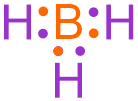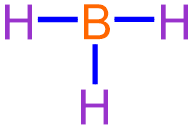3.18: Covalent Bonding: Electron-Deficient Exceptions to the Octet Rule
- Page ID
- 215726
\( \newcommand{\vecs}[1]{\overset { \scriptstyle \rightharpoonup} {\mathbf{#1}} } \)
\( \newcommand{\vecd}[1]{\overset{-\!-\!\rightharpoonup}{\vphantom{a}\smash {#1}}} \)
\( \newcommand{\id}{\mathrm{id}}\) \( \newcommand{\Span}{\mathrm{span}}\)
( \newcommand{\kernel}{\mathrm{null}\,}\) \( \newcommand{\range}{\mathrm{range}\,}\)
\( \newcommand{\RealPart}{\mathrm{Re}}\) \( \newcommand{\ImaginaryPart}{\mathrm{Im}}\)
\( \newcommand{\Argument}{\mathrm{Arg}}\) \( \newcommand{\norm}[1]{\| #1 \|}\)
\( \newcommand{\inner}[2]{\langle #1, #2 \rangle}\)
\( \newcommand{\Span}{\mathrm{span}}\)
\( \newcommand{\id}{\mathrm{id}}\)
\( \newcommand{\Span}{\mathrm{span}}\)
\( \newcommand{\kernel}{\mathrm{null}\,}\)
\( \newcommand{\range}{\mathrm{range}\,}\)
\( \newcommand{\RealPart}{\mathrm{Re}}\)
\( \newcommand{\ImaginaryPart}{\mathrm{Im}}\)
\( \newcommand{\Argument}{\mathrm{Arg}}\)
\( \newcommand{\norm}[1]{\| #1 \|}\)
\( \newcommand{\inner}[2]{\langle #1, #2 \rangle}\)
\( \newcommand{\Span}{\mathrm{span}}\) \( \newcommand{\AA}{\unicode[.8,0]{x212B}}\)
\( \newcommand{\vectorA}[1]{\vec{#1}} % arrow\)
\( \newcommand{\vectorAt}[1]{\vec{\text{#1}}} % arrow\)
\( \newcommand{\vectorB}[1]{\overset { \scriptstyle \rightharpoonup} {\mathbf{#1}} } \)
\( \newcommand{\vectorC}[1]{\textbf{#1}} \)
\( \newcommand{\vectorD}[1]{\overrightarrow{#1}} \)
\( \newcommand{\vectorDt}[1]{\overrightarrow{\text{#1}}} \)
\( \newcommand{\vectE}[1]{\overset{-\!-\!\rightharpoonup}{\vphantom{a}\smash{\mathbf {#1}}}} \)
\( \newcommand{\vecs}[1]{\overset { \scriptstyle \rightharpoonup} {\mathbf{#1}} } \)
\( \newcommand{\vecd}[1]{\overset{-\!-\!\rightharpoonup}{\vphantom{a}\smash {#1}}} \)
\(\newcommand{\avec}{\mathbf a}\) \(\newcommand{\bvec}{\mathbf b}\) \(\newcommand{\cvec}{\mathbf c}\) \(\newcommand{\dvec}{\mathbf d}\) \(\newcommand{\dtil}{\widetilde{\mathbf d}}\) \(\newcommand{\evec}{\mathbf e}\) \(\newcommand{\fvec}{\mathbf f}\) \(\newcommand{\nvec}{\mathbf n}\) \(\newcommand{\pvec}{\mathbf p}\) \(\newcommand{\qvec}{\mathbf q}\) \(\newcommand{\svec}{\mathbf s}\) \(\newcommand{\tvec}{\mathbf t}\) \(\newcommand{\uvec}{\mathbf u}\) \(\newcommand{\vvec}{\mathbf v}\) \(\newcommand{\wvec}{\mathbf w}\) \(\newcommand{\xvec}{\mathbf x}\) \(\newcommand{\yvec}{\mathbf y}\) \(\newcommand{\zvec}{\mathbf z}\) \(\newcommand{\rvec}{\mathbf r}\) \(\newcommand{\mvec}{\mathbf m}\) \(\newcommand{\zerovec}{\mathbf 0}\) \(\newcommand{\onevec}{\mathbf 1}\) \(\newcommand{\real}{\mathbb R}\) \(\newcommand{\twovec}[2]{\left[\begin{array}{r}#1 \\ #2 \end{array}\right]}\) \(\newcommand{\ctwovec}[2]{\left[\begin{array}{c}#1 \\ #2 \end{array}\right]}\) \(\newcommand{\threevec}[3]{\left[\begin{array}{r}#1 \\ #2 \\ #3 \end{array}\right]}\) \(\newcommand{\cthreevec}[3]{\left[\begin{array}{c}#1 \\ #2 \\ #3 \end{array}\right]}\) \(\newcommand{\fourvec}[4]{\left[\begin{array}{r}#1 \\ #2 \\ #3 \\ #4 \end{array}\right]}\) \(\newcommand{\cfourvec}[4]{\left[\begin{array}{c}#1 \\ #2 \\ #3 \\ #4 \end{array}\right]}\) \(\newcommand{\fivevec}[5]{\left[\begin{array}{r}#1 \\ #2 \\ #3 \\ #4 \\ #5 \\ \end{array}\right]}\) \(\newcommand{\cfivevec}[5]{\left[\begin{array}{c}#1 \\ #2 \\ #3 \\ #4 \\ #5 \\ \end{array}\right]}\) \(\newcommand{\mattwo}[4]{\left[\begin{array}{rr}#1 \amp #2 \\ #3 \amp #4 \\ \end{array}\right]}\) \(\newcommand{\laspan}[1]{\text{Span}\{#1\}}\) \(\newcommand{\bcal}{\cal B}\) \(\newcommand{\ccal}{\cal C}\) \(\newcommand{\scal}{\cal S}\) \(\newcommand{\wcal}{\cal W}\) \(\newcommand{\ecal}{\cal E}\) \(\newcommand{\coords}[2]{\left\{#1\right\}_{#2}}\) \(\newcommand{\gray}[1]{\color{gray}{#1}}\) \(\newcommand{\lgray}[1]{\color{lightgray}{#1}}\) \(\newcommand{\rank}{\operatorname{rank}}\) \(\newcommand{\row}{\text{Row}}\) \(\newcommand{\col}{\text{Col}}\) \(\renewcommand{\row}{\text{Row}}\) \(\newcommand{\nul}{\text{Nul}}\) \(\newcommand{\var}{\text{Var}}\) \(\newcommand{\corr}{\text{corr}}\) \(\newcommand{\len}[1]{\left|#1\right|}\) \(\newcommand{\bbar}{\overline{\bvec}}\) \(\newcommand{\bhat}{\widehat{\bvec}}\) \(\newcommand{\bperp}{\bvec^\perp}\) \(\newcommand{\xhat}{\widehat{\xvec}}\) \(\newcommand{\vhat}{\widehat{\vvec}}\) \(\newcommand{\uhat}{\widehat{\uvec}}\) \(\newcommand{\what}{\widehat{\wvec}}\) \(\newcommand{\Sighat}{\widehat{\Sigma}}\) \(\newcommand{\lt}{<}\) \(\newcommand{\gt}{>}\) \(\newcommand{\amp}{&}\) \(\definecolor{fillinmathshade}{gray}{0.9}\)- Identify which elements are unable to achieve octets when forming covalent molecules.
- Draw Lewis structures of covalent molecules that contain electron-deficient atoms.
- Write the chemical formulas and chemical names of covalent molecules that contain electron-deficient atoms.
As discussed previously, electrons are most stable when they exist in octet configurations. However, some elements are unable to fill their valence shells when bonding, due to inherent deficiencies in their atomic electron configurations. Other elements are able to achieve octets when bonding, but are also able to expand their valences to contain more than eight electrons. Elements that exhibit each of these exceptions to the "octet rule" can still be used to form stable covalent molecules, as will be discussed in greater detail in the current and following sections of this chapter, respectively.
Elements that Cannot Achieve Octets When Bonding
Recall that covalent bonds are produced when unpaired electrons found within two atoms, which must be classified as either non-metals or metalloids, interact to form a shared pair of electrons. After successfully pairing all of their unpaired electrons, most of the elements that are able to bond covalently achieve octet configurations through a combination of bonded, or shared, and lone, or unshared, pairs of electrons. For example, carbon and silicon, which are both found in Group 4A, each contain four valence electrons, which are all unpaired when represented in a chemically-correct electron dot structure. Therefore, these elements are able to form four shared pairs of electrons when interacting with other elements. The non-metals found in Groups 5A, 6A, and 7A, which have five, six, and seven valence electrons, respectively, have fewer unpaired electrons in their electron-dot structures and, therefore, create fewer shared pairs of electrons when bonding. However, due to the existence of one or more lone pairs that contribute to their overall electron configurations, these non-metals are still able to achieve octets when bonding.
In contrast, hydrogen and boron are unable to achieve octet configurations when bonding. These elements can still form stable covalent molecules by pairing their electrons with those found in other non-metals. However, both hydrogen and boron lack the ability to form four bonds and do not possess any paired electrons that can contribute to their overall electron configurations.
Drawing Lewis Structures of Covalent Molecules that Contain Electron-Deficient Atoms
The Lewis structure of a covalent molecule that contains electron-deficient atoms, such as hydrogen and boron, can be drawn by following the steps presented in Section 3.15.
Based on the combinations listed in Section 3.14, hydrogen, a non-metal, and boron, a metalloid, will combine to form a covalent molecule, as stated above. Since hydrogen is found in Group 1A of the periodic table, it contains 1 valence electron. Boron, which is located in Group 3A, has 3 valence electrons. A chemically-correct electron dot structure for each of these elements is shown below.

Based on the structures shown above, hydrogen contains 1 unpaired electron, and boron has 3 unpaired electrons. The element with more unpaired electrons will become the central atom in a Lewis structure, and the other element will be used as a surrounding atom. One surrounding atom should be paired with each of the central atom's unpaired electrons, in order to create a shared pair of electrons. As the central atom in a covalent molecule usually has more than one unpaired valence electron, multiple surrounding atoms are generally used in the pairing process. When executing this pairing step, the electron dot structure for the surrounding atom should be rotated so that its unpaired electron aligns with an unpaired electron on the central atom. Because the dots on an electron dot structure can be placed on any "side" of the elemental symbol, this rotation changes the orientation of the structure, but does not alter its meaning.
In the current example, boron has more unpaired electrons than hydrogen. Therefore, boron is the central atom, and hydrogen is used as the surrounding atom. Since boron's unpaired electrons are located on the left, right, and bottom "sides" of the electron dot structure that is shown above, one electron dot structure for hydrogen should be placed in each of these locations. The resultant structure is shown below.

This structure contains three shared pairs of electrons, located on the left, right, and bottom "sides" of boron's electron dot structure. Each of these shared pairs was created by pairing one of boron's unpaired electrons with an unpaired electron from hydrogen. As these electron pairs are written between two elemental symbols, these electrons contribute to the overall electron configuration of both atoms.
Since all of the electrons shown above are paired, this structure represents the most stable bonding arrangement that can be achieved by combining boron and hydrogen. However, after correctly executing the pairing process, none of the elemental symbols in this structure are by eight, fully-paired dots. This information is visually-highlighted in the structure shown below using a blue circle around boron and a green box around each hydrogen. Boron achieves a sextet configuration when bonding, as it is ultimately surrounded by six total electrons, and each hydrogen is only associated with two total electrons and, therefore, achieves a duet configuration when bonding. Because hydrogen and boron are unable to achieve octet configurations when bonding, the resultant molecule, while stable, is considered "electron deficient."

Finally, in order to generate a structure that is more visually-appealing, each shared pair of electrons is replaced with a line that connects the adjacent elemental symbols and represents the covalent bond that is formed between them.

The structure shown above, which is a chemically-correct representation of a covalent compound, is a Lewis structure that represents the molecule that is formed when hydrogen and boron bond with one another.
Writing Chemical Formulas of Covalent Molecules that Contain Electron-Deficient Atoms
The chemical formula of a covalent molecule that contains electron-deficient atoms, such as hydrogen and boron, can be determined using the rules presented in Section 3.16.
For a covalent molecule, the information represented in its chemical formula must be a direct reflection of its Lewis structure. Elemental symbols are incorporated into a chemical formula by counting the number of times that each symbol appears in the corresponding Lewis structure. In order to ensure consistent formatting, the elemental symbol that appears fewer times is written first in a covalent chemical formula, and subscripts are used to indicate how many times each elemental symbol appears in the Lewis structure. As indicated previously, values of "1" are usually implicitly-understood in chemistry and, therefore, should not be written in a chemical formula. The subscripts must not be reduced to the lowest-common ratio of whole numbers, even if it is mathematically-possible to do so, as dividing the subscripts would cause their values to be inconsistent with the number of times that each elemental symbol appears in the Lewis structure.
The Lewis structure shown above contains three hydrogen atoms and one boron atom. As there are fewer boron atoms in the Lewis structure, the elemental symbol "B" is written first in the corresponding chemical formula, and hydrogen's elemental symbol, "H," is written second. No subscript should be written on boron's elemental symbol, as values of "1" should not be explicitly-written in a chemical formula. A subscript of "3" should be written on hydrogen's elemental symbol. The resultant chemical formula, BH3, accurately summarizes the information in the Lewis structure shown above and, therefore, is the chemically-correct formula for this covalent molecule.
Naming Covalent Molecules that Contain Electron-Deficient Atoms
The chemical name of a covalent molecule that contains electron-deficient atoms, such as hydrogen and boron, can be derived using the information outlined in Section 3.17.
For a covalent molecule, the information represented in its chemical name must also be a direct reflection of its Lewis structure. Therefore, the chemical name of a covalent molecule must not only contain information that indicates the identities of its constituent elements, but also must reflect how many of each of those elements are present within the molecule. Note that, if written properly, the chemical formula for a covalent molecule also contains this information and, therefore, can be used as the basis for developing a chemical name. Elemental names are incorporated into a covalent molecule's chemical name in the order in which their corresponding elemental symbols appear in the chemical formula. The suffix on the second elemental term is replaced with "-ide," in order to indicate its secondary placement within the chemical formula. Finally, since the subscripts in a covalent chemical formula are used to indicate how many times each elemental symbol appears in the molecule's Lewis structure, corresponding numerical prefixes must be incorporated into the molecule's chemical name. Remember that the prefix "mono-" is never used to change the first elemental term in a covalent chemical name and should only be used as a modifier on the remaining term if the secondary element is oxygen. Finally, an "a" or "o" at the end of a prefix is usually dropped if the name of the element that is being altered begins with a vowel.
Since the elemental symbol "B" appears first in the chemical formula that was developed above, "boron" is the basis of the first word in the molecule's chemical name. The subscript on this elemental symbol, an unwritten "1," corresponds to prefix of "mono-." However, this prefix is not used to alter the first elemental term in a covalent chemical name. Therefore, the first word in the chemical name of this molecule is "boron."
Because the elemental symbol "H" is written second in the chemical formula that was developed above, "hydride" becomes the basis of the second word in the molecule's chemical name. The suffix on this elemental term is "-ide," as an indicator of its secondary placement within the chemical formula. The subscript on this elemental symbol, a "3," corresponds to prefix of "tri-." Therefore, the second word in the chemical name of this covalent molecule is "trihydride."
The result of combining these words, "boron trihydride," is the chemically-correct name for BH3.

